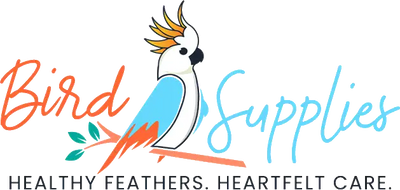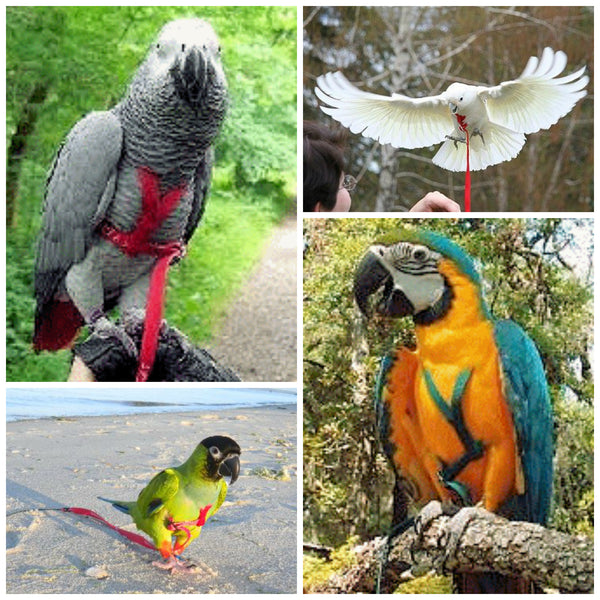Train Your Parrot to Wear a Bird Leash
Use Caution With Bird Leash Training:
-
Always teach your bird to wear a bird leash indoors prior to using your bird leash outdoor
-
Bird leashes are intended for use when taking your bird outside. Never leave your bird outside unattended.
-
Never tie your bird to his perch with a bird leash. He may become startled and panicked causing injury or death.
-
Always check to see that your bird is able to breathe easily in the bird leash. You should be able to slip a finger between the bird leash strap and the bird's body.
Do not attempt leash training your with a bird leash color that scares your bird.
Make sure that all experiences are positive when you're introducing your bird to a leash so that it doesn't associate wearing the bird leash with stressful situations.
Training your pet bird to wear a bird leash can open up a world of fun and socialization possibilities for both you and your parrot. Before you start bird leash training your parrot learn what treats that it enjoys the most. Generally, something small that can be eaten quickly works well to assist in training sessions. Enthusiastic verbal praise and "scritches" in favorite places also are great reinforces to training your bird. Next, figure out a consistent time of day that you can devote for training. Shoot for at least 10 - 15 minutes of training each day. Keep the training sessions short so your bird does not tire and so the sessions remain positive.
To make training fun, start and end each training session with a short playtime. Some parrots will become comfortable with the bird leash within a matter of weeks while others take longer. Check out our Clicker Training for Birds book. When done properly, clicker training speeds bird leash bird harness training for most birds.
Helpful Tips
-
Choose a bird leash color that your parrot likes. If you are not sure, choose a color that is in your bird's feathers.
-
Use Clicker Training to teach your bird to tolerate you touching of its head & wings.
-
Know the signs that your bird gives you when it is tiring. Some bird's bite, others stop cooperating. Plan to limit training sessions to 10-15 minutes
-
Watch for body language that indicates your bird may be scared during training sessions.
-
Pick a consistent time to practice, preferably on a daily basis.
-
ALWAYS remain positive during leash training sessions.
Step by Step Bird Harness Training
1. Place your bird on a table or a training stand in a location where it feels comfortable and can be attentive. Place the bird leash in your hand, hiding most of it. Show your bird a small amount of the bird leash. When the parrot reaches out for the bird leash, move it slightly away making a hide and seek game out of the session. Immediately praise your bird and reward it with a treat for showing curiosity toward the bird leash. Repeat this process several times, praising and rewarding each time.
2. After your bird has shown consistent curiosity of the bird leash, allow it to touch or "beak" the bird leash for short periods of time. Generously praise and reward. Continue showing your parrot more of the bird leash, timing the experience so your bird remains curious and comfortable. If your bird pulls on the bird leash, let it slip a little from your hand, but not so much that the bird is startled. The long leash may look like a snake, a predator to your bird, so take this phase slowly. Reward each progressive step generously.
3. Continue with partially hiding the bird leash until your parrot is comfortable touching it. You will want to raise your bird's curiosity regarding the bird leash until your bird feels comfortable with the leash being in close proximity to its body. Always reward each step of progress generously. Stop on a positive note. Make a game of your bird's natural curiosity to speed learning.
4. Lay the entire bird leash out for your parrot to see. Undo the clips. Let your bird become familiar with the sound of the clips snapping together. When your bird is comfortable with the bird leash appearance and sounds, slip the head portion of the leash on. Reward your bird for allowing the bird leash to be placed over its head. Likewise, reward your bird when it allows the leash to be removed. If your bird becomes fearful, make sure you end the training session on a positive note. Praise each progressive step generously.
5. Once your bird feels comfortable with the bird leash over its head, continue with training it to allow the leash to be placed over its back and around its wings. Generously praise this next step of progress.
6. When your bird is comfortable with you maneuvering its wings, move to the next step of clipping the bird leash in place. Again, reward with verbal praise and treats at each new step.
7. Observe how the bird leash fits and slowly adjust it to an appropriate fit. Allow your bird to observe you working with the clips and hear them clicking open and shut.
7. Once your bird is comfortable with having the bird leash placed on more than one part of its body, try closing one of the clips. Open it up quickly and remove the leash. DO NOT allow the bird to become frightened by the leash. Praise the bird for cooperation and reassure it when fearful.
8. Once your bird is comfortable with having the bird leash clipped on, leave it on for longer and longer periods of time. Start slowly, possibly 30 seconds, and then remove the leash before the bird becomes agitated. Praise each progressive step generously.
9. Once your bird tolerates the leash left in place for a few minutes, work toward having it completely clipped in place with the leash part attached. Slowly increase the time the bird leash is left on.
10. Once your bird tolerates wearing the bird leash for approximately 5 minute segments, begin moving the bird about the house. Make sure your tolerates wearing the leash in new situations prior to taking it outside in the bird leash.
11. Make sure that your bird is exposed to wearing the bird leash on a regular basis in order to maintain the training.



